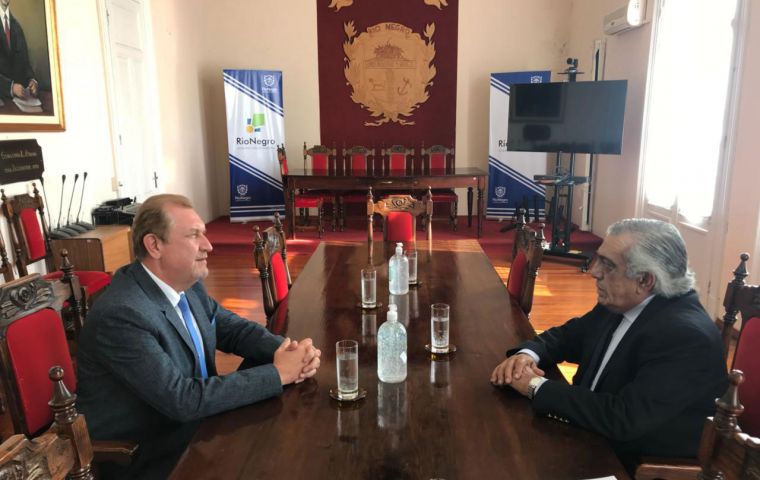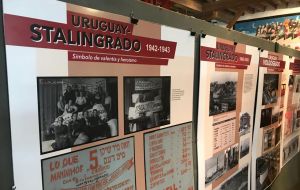MercoPress. South Atlantic News Agency
Uruguayan town puts historic support to Soviet troops during Battle of Stalingrad on display
 Moscow's Ambassador to Montevideo Andrei Budáev with Rio Negro Mayot Omar Lafluf (Pic Russian Embassy)
Moscow's Ambassador to Montevideo Andrei Budáev with Rio Negro Mayot Omar Lafluf (Pic Russian Embassy)  “It is our duty and our obligation to pass the truth on to new generations,” Ambassador Andrei Budáev said
“It is our duty and our obligation to pass the truth on to new generations,” Ambassador Andrei Budáev said The support from the Uruguayan town of San Javier to the Soviet Army in the Battle of Stalingrad has been put on display for visitors to see at an exhibition in Fray Bentos.
San Javier, founded more than a century ago by Russian immigrants in the Uruguayan department (province) of Río Negro, did play a part in the Soviet Army's fight against Nazi German troops in Stalingrad during World War II.
Proof of that support are the items such as photographs and documents on display at an exhibition called 'San Javier, a story of solidarity in the Second World War' at the Museum of the Industrial Revolution (formerly the Anglo meat producing plant) in the departamental capital, Fray Bentos.
The assistance consisted of warm clothing, money and letters of encouragement and other basic supplies. “We are talking about a wave of solidarity from both the ethnic Russians of San Javier, as well as Uruguayans in general,” said Sergey Brilev, chairman of the NGO Bering-Bellingshausen Institute for the Americas during the opening ceremony over this past weekend.
Brilev, a renowned Russian journalist and TV host also stressed that, despite not having participated militarily in World War II, Uruguay produced 'corned beef' at the Anglo meat processing plant whose site was declared a World Heritage Site by UNESCO in 2015, to feed the Allied forces.
“That Uruguayan 'corned beef' constituted 15% of the Allied supplies of canned meat to the Soviet Union, which there, on the banks of the Volga River, basically decided the fate of World War II,” he noted.
Meanwhile, Russia's Ambassador to Uruguay Andrei Budáev, recalled that the exhibition is dedicated to one of the most important and bloody battles of the Great Patriotic War (1941-1945 in the USSR).
“It is very important to preserve the historical truth, especially when there are attempts by some political forces to rewrite history, glorify Nazism, diminish the decisive role of the Soviet Army and the Soviet Union in the final defeat of Nazism. That is why it is our duty and our obligation to pass the truth on to new generations, to our children and grandchildren, so that they never allow a tragedy of such magnitude to ever be repeated in the history of humanity,” he went on.
Río Negro Mayor Omar Lafluf said that “the cooperation that occurred from Uruguay in the battle of Stalingrad, especially from the Russian colony of San Javier, is a source of pride” for the region. He added that the Anglo plant “is the greatest pride we have” because in that factory “food was produced for the armies in the First and Second World War.”
Nevertheless, Lafluf admitted that Uruguay's aid to the USSR during the battle of Stalingrad was “a new fact” regional authorities were not aware of up until now.
Curator of the exhibition is Uruguayan writer and former National Library Director Raúl Vallarino, who also pointed out “there is ignorance, even of the new generations”, about the solidarity aid ofhe town of San Javier to the combatants of the Battle of Stalingrad. “This exhibition comes to fill a deficit in the knowledge of what really happened, because there we were all fighting for the free world,” he told the Russian newsagency Sputnik.
According to Vallarino, the solidarity aid sent by the Russian community of San Javier ”is something that has to be shown and known, because nobody knew about it, at least in Uruguay.“
Vallarino also underlined ”there was ignorance that [the corned beef] came from here, because when that huge amount came out, the United States changed the label and put it as made in the US, but it was made here, in Uruguay,“ at least the bulk of it.
Mauro Delgrosso, Director of the Museum of the Industrial Revolution in Fray Bentos, told Sputnik that the exhibition ”shows us the reality of how crude the war was, something that did not happen here” where there was, however, “a production connection that came from this factory to those corners of the world so battered, and that fills us to a certain extent with pride.”
Uruguayan Heritage Commission General Director William Rey, described said he believed “it is very important to always build relationships, especially with countries that have bequeathed us settlers, that have bequeathed us culture and that have allowed us to have true reservoirs of culture from other countries.”
In the case of Russian immigrants, they added new knowledges and “even productive cultural practices: the presence of sunflower, the presence of ways of working the land.” (Souce: Sputnik)




Top Comments
Disclaimer & comment rulesCommenting for this story is now closed.
If you have a Facebook account, become a fan and comment on our Facebook Page!